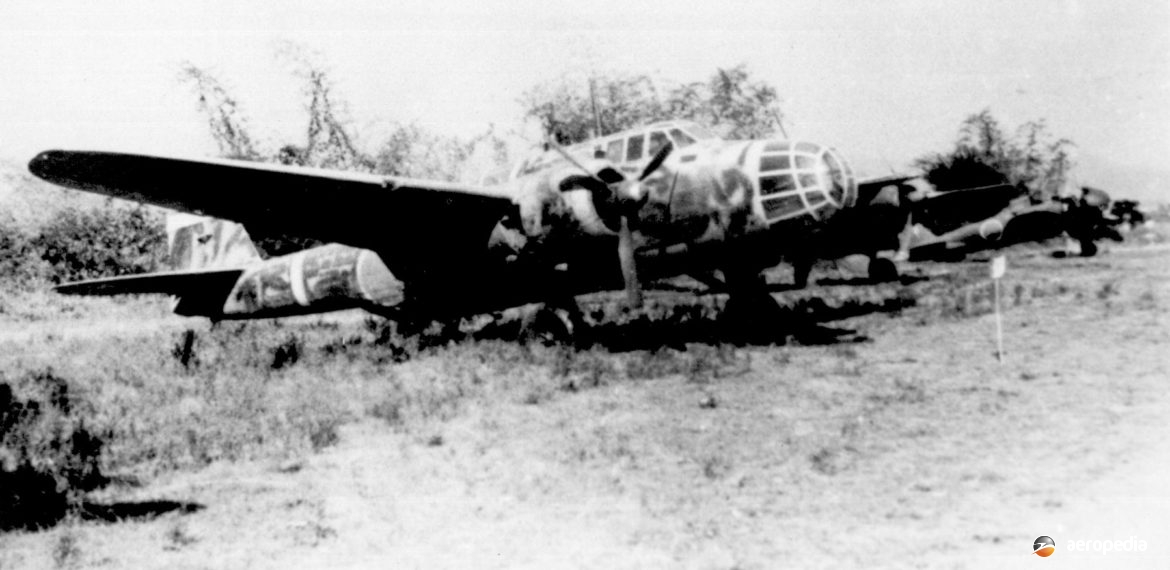Photograph:
An abandoned Kawasaki Ki.48 Lily on one of the Pacific islands (RAAF Museum)
Country of origin:
Japan
Description:
Twin-engine light bomber
Power Plant:
Two 858 kw (1,150 hp) Nakajima Ha-115 fourteen-cylinder two-row air-cooled radial engines
Specifications:
- Wingspan: 17.45 m (57 ft 3 in)
- Length: 12.75 m (41 ft 10 in)
- Height: 3.8 m (12 ft 5 19/32 in)
- Wing area: 40 m² (430.57 sq ft)
- Max speed at 5,600 m (18,375 ft): 505 km/h (314 mph)
- Climb to 5,000 m (16,405 ft): 8 mins 30 secs
- Service ceiling: 10,100 m (33,135 ft)
- Max range: 2,400 km (1,491 miles)
- Empty weight: 4,550 kg (10,031 lb)
- Max loaded weight: 6,750 kg (14,881 lb)
History:
In 1937 the Japanese Army sought an aircraft manufacturer to provide a design for a high-performance twin-engine light bomber with a crew of four, and Kawasaki Kokuki Kogyo KK, with a team led by Takeo Doi, provided a design for a cantilever mid-wing monoplane powered initially by two 709 kw (950 hp) Nakajima Ha-25 radial engines driving variable-pitch propellers.
The first of four prototypes of the Kawasaki Ki.48 series, which became known by the Allied code-name Lily, flew for the first time in July 1939 and the type was known as the Army Type 99 Twin-Engine Light Bomber 1A, entering service with Japanese Army units in mid 1940.
First unit to operate the type in combat was the 45th Sentai in northern China, where it proved to be very successful due to a lack of opposition. Later it saw service against British and Australasian forces in Malaya and Burma, and American forces in The Philippines. It was later deployed to bases in the Netherlands East Indies and New Guinea. But as the tide of the war turned, large numbers were destroyed on the ground in New Guinea, despite efforts by Japanese forces to camouflage and disperse aircraft on jungle airfields.
The Lily had a crew of four. Once the Japanese forces commenced their Pacific campaign, it was found the type was wanting in a number of respects when it came up against Allied forces and eventually most of the type’s operations occurred at night.
The development of the type continued throughout the war and the main production model was the Ki.48-II in 1942, known as the Army Type 99 Twin-Engine Light Bomber Model 2A, this having up-rated Nakajima Ha-115 engines, a lengthened fuselage, armour protection for the crew, and self-sealing fuel tanks.
Towards the end of the war the Lily could not survive against Allied fighters. By October 1944 it had been declared obsolescent and was used in Kamikaze attacks, particularly in the Okinawa area, being fitted with an 800 kg (1,764 lb) bomb-load which was triggered by contact with the target by means of a long-rod protruding from the nose.
A total of 1,977 Ki.48s was built at the Gifu plant of Kawasaki.
The 45th Sentai was the first unit deployed to the New Guinea Theatre, arriving via Rabaul in New Britain on the aircraft carrier ‘Zuikaku’ in January 1943. On 27 January 1943 nine Ki.48s escorted by 74 Ki.43 Oscar fighters made a raid on Guadalcanal, dropping their bombs near American positions around the Matanikau River. In the following months the 45th Sentai was stationed briefly at Munda and then moved to airfields around Wewak, Papua New Guinea. By May 1943 some 50 were based in the area assigned to the 34th, 45th and 208th Sentais.
The Ki.48 was also attached to reconnaissance units, such as the 10th Reconnaissance Sentai. With the Ki.51 Sonia they were used to scour the valleys of coastal Papua New Guinea and occasionally were used for forward air control duties.
The Ki.48 was one of a number of Japanese types which made raids on Darwin, NT. Occasionally Ki.48s made reconnaissance missions over northern Australia and the first concerted bombing effort was made by nine Ki.48s of the 75th Sentai, along with 18 Nakajima Ki.49 Donryus of the 61st Sentai, escorted by 22 Nakajima Ki.43 Oscars of the 59th Sentai, which raided Darwin on 20 June 1943. The Ki.49s linked up with the fighter force over Timor Sea but the Ki.48s proceeded unprotected. The Ki.49s and Ki.43s were intercepted by Supermarine Spitfires of Nos 54, 452 and 457 Squadrons RAAF, with two Ki.49s shot down, one east of Darwin on Koolpinyah Station and the other into Adam Bay. On this occasion the Ki.48 light bombers made low-level bombing and strafing runs on the Darwin airstrip, making a number of passes, dropping 250 kg (551 lb) high explosive and 60 kg (132 lb) anti-personnel bombs before heading off over Charles Point.
On 23 June 1943 Australian Beaufighters attacked the Japanese airfield at Selaroe in the Tanimbar Islands in the Timor Sea and strafed and destroyed two Ki.48s on the ground.
On 27 September 1943 the Ki.48 was seen over Australia for the last time, the airfield and military logistics base at Drysdale Mission in Western Australia being attacked. This area was used as an ammunition depot and refuelling base for aircraft carrying out anti-submarine operations on the west coast between Darwin and Fremantle, WA. Royal Australian Air Force (RAAF) Beaufighter aircraft of No 31 Squadron often staged through the base on operations to attack Japanese bases at Penfui and Koepang in Timor.
For this mission 21 of the 75th Sentai Ki.48s were escorted by 21 Mitsubishi A6M-2 fighters of the 202nd Sentai of the Japanese Navy (rather than Army aircraft as was usual). Bombs were dropped and the A6M-2s also strafed the airfield. Little damage was sustained to the airfield but a slit-trench received a direct hit, killing five. The Japanese force was not intercepted and no aircraft were lost.
The wreck of a Ki.48 (c/n 1490) has remained at Sialum, New Guinea, where it force landed; and another has remained at Danip airfield north of Alexishafen.

